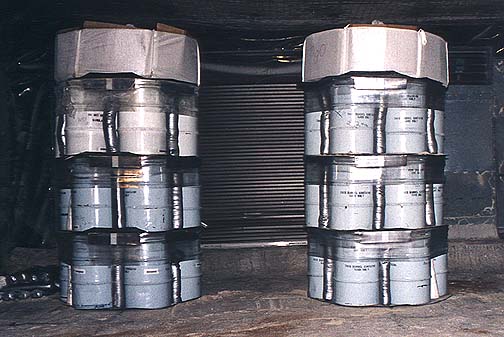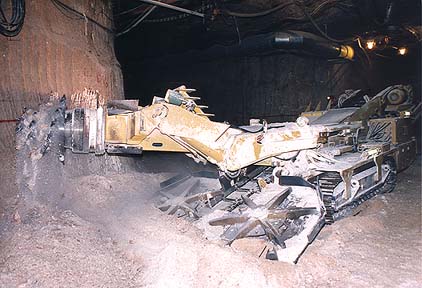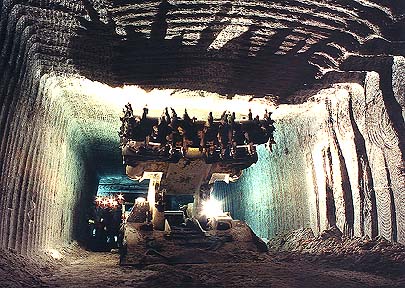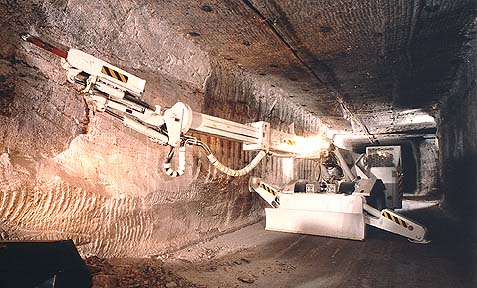

Beneath Apache Country: Inside
WIPP (Waste Isolation Pilot Project)
by Alan Sussex
Part Three
The power outage leaves us in darkness 2150 feet below ground. It’s a bit eerie. Our very strong helmet lamps bounce off the salt walls ahead and around us.
I think about the ceiling and walls moving slowly inwards and how it’s supposed to help encapsulate the plutonium waste once it’s down here. Walls moving tightly around the drums, packing them in. I don’t understand how that will make them more secure, but it could create more of a problem if things don’t go as planned. With the highly corrosive effect of the salt on these steel drums it won’t take long for them to be eaten through. With their contents exposed and contaminating the salt around them, not only would the drums and contents have to be dealt with, but now also the millions of tons of contaminated salt surrounding them.

Underground at the Waste Isolation Pilot Plant (WIPP) magnesium oxide sacks and tubes are placed around the waste drums to inhibit the release of radionuclides during the decay process. It is an added DOE assurance in the unlikely event of a drilling intrusion
They could probably excavate the 6 ½ million cubic feet of original waste again, and maybe 50 million tons or so of contaminated salt at great expense. But then where would you take it?
Once taken down and buried no matter what happens it’s probably going to stay there until it has totally decomposed some 500,000 years from now. There just isn’t any place else to put it, it would be too expensive and difficult to retrieve it. The Genie is out of the jug.
The salt tunnels are surprisingly smooth to drive on. Stopping at each intersection, Howard blows the horn for safety and we proceed. Workers riding in other carts cross our paths at intersections in front of us. Their headlamps bouncing around in the darkness makes me feel like I’m in a science fiction time warp. About 100 workers are down here at a time, it’s a busy place.
We’re now out of the darkness and into the normally dimly-lit tunnels, passing an ambulance and fire vehicle tucked into a lit alcove.
  |
|
Further down is one of the mining vehicles that cuts the salt and digs the tunnels. A laser-guided machine that will cut perfectly level; its 30-inch diameter cone-shaped, diamond studded cutter spins in front. The driver, sitting low and towards the rear, is able to guide the cutter in any direction because of the flexible arm that the cone is attached to. Salt falls onto a conveyor that’s part of it and is moved to the rear where it’s loaded onto a truck. From there it’s taken over to the salt elevator and up top to be spread out on the surface. Another salt-mining machine, the Marietta 3612, has a 15-foot revolving drum up front with diamond tipped claws. It removes 700 tons per shift.
Our next step is the test chamber where the first tests will be conducted on the plutonium contaminated waste. These tests will be conducted down here on site. All necessary equipment is now in place, and instruments are linked with computer stations that will gather data and monitor gasses and heat created by decomposing contaminated waste and drums.
The test bin that I examined had more than a dozen valves and lines attached to it, to monitor and control gas generation. Much of the waste consists of paper, rags, tools, clothing, plastics and other organic material. In addition, heavy toxic metals such as lead, mercury, and cadmium will be present along with solvents, all a product of weapons production. Two types of tests will be conducted to determine the generation and behavior of gasses underground within the salt. These gasses are generated by the corrosion of metals, the decomposition of organic waste, and by the action of radiation on waste material.
Laboratory tests are now being conducted at other facilities, tests that will take place shortly on the site. Depending on what is learned, wastes may have to be treated to reduce gas generation with gas absorbing materials called getters.
Additional tests are being conducted in the "round room," Experimental Room H. A round central pillar of salt still connected to the ceiling and floor about 25 feet in diameter is wrapped and heated. Another program of the test phase will be to gather information on the chemical interaction of brine and waste. Brine will be added to the waste within the bin to simulate moisture that’s present within the salt beds.
Brine is leftover 225 million year-old ocean water that still exists within and under the 3000 feet of salt, Supersaturated with salt, the brine cannot absorb more.
Once the testing phase is concluded (5 years) the results will be upscaled and applied to the 6.5 million cubic feet of plutonium contaminated waste to be buried here.
Part Four
Leaving the experimental area where the test bins are, we drove south through the salt tunnels. As we headed toward the Circular Brine Inflow Test Room I thought of the 6.5 million cubic feet of plutonium waste that will eventually be down here starting to decompose - all the clothing, tools, paper, rags, plastics, solvents, leads, mercury and the containment drums themselves.
The action of radiation on those wastes, and the highly corrosive salt, generate gasses. Decomposing garbage of any landfill creates methane gas which rises to the surface and is sometimes burned off; I wonder if the radioactive gasses here will also find their way to the top, and if so, will they still contain plutonium 239? Will the gasses eventually be forced to the surface, or might something even more dangerous and deadly occur?
I thought about what might lie between the bottom of the salt layer at 3000 feet and the bedrock at 4000 feet. On the geologic profile that area is labeled sea level salt and anhydrite known as the Castle formation. At 4000 feet is bedrock, the Beil Canyon formation. Between, it is brine or Supersaturated water. Within the salt itself is what’s left of 225 million year-old ocean water. It can be seen seeping out of the walls in white streaks.
The salt deposits themselves are the remains of an ancient ocean that used to cover much of North America. Portions of the salt exist up into Minnesota. Due to geologic changes this ocean became isolated and evaporated.
If there’s still brine within the salt itself, is there more brine under the salt? Under great pressure?
Oil still finds its way to the surface through fissures and openings created when the crust moves a bit. If there is pressurized brine under the salt. Could the gas and pressure create a path between the waste and the water below? Might not the water pass through the plutonium and rise to the surface through weakened openings?
Like coffee perking, water would bring contaminated materials to the surface. Once on the surface, the sun would lift vapor into the atmosphere, spreading plutonium on the winds.
A millionth of a gram kills. Breathed in or eaten by animals or humans, plutonium causes cancer and death.
The scenario had gone through my mind some time ago when I had first started to examine this project.
As he headed toward the Circular Brine Test Room, I recalled the stunned looks and dead silence as I presented this theory to Howard and Curtis while eating lunch earlier that day.
I could tell they were shocked. Silence and wide-eyed blank stares. I asked, could it happen? I got no response.
I then raised the question about how originally WIPP had planned to build on a site miles away, next to Highway 128, and that they had drilled some test holes, had stuck pressurized brine that flooded several square miles. Some refer to it as Lake WIPP. I had passed this lake earlier in the morning on my way to the plant.
They said they knew nothing about it having been caused by drilling - and said that rainfall raised and lowered it. They added that it is only a few feet deep.
Parts 5 and 6
